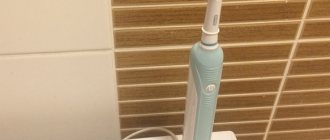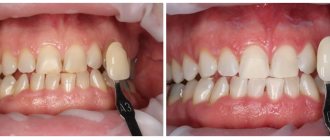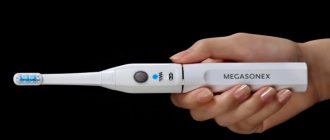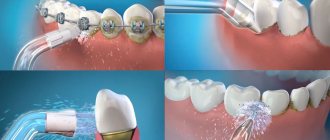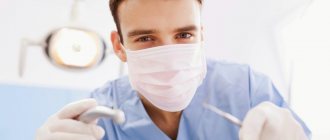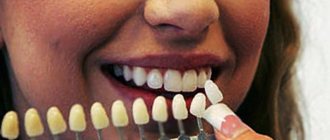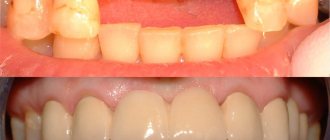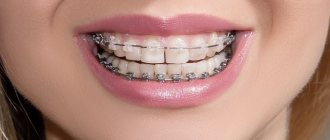There are a huge number of electric brushes on the market, which differ from each other in their operating principles and functions. Ultrasonic brushes are considered the most modern. They operate on the basis of ultrasonic waves that are transmitted from the device to the person during cleaning. We'll tell you how to brush your teeth with this brush.
An ultrasonic toothbrush uses ultrasonic waves to cleanse teeth from food debris and plaque. This device consists of a handle with a battery or battery, a body equipped with a high-frequency generator, and a head with bristles, like a regular toothbrush.
In this article
- Working principle of an ultrasonic toothbrush
- Ultrasonic brush: indications and contraindications
- Ultrasonic brush: pros and cons
- How to brush your teeth with an ultrasonic brush
- How to choose an ultrasonic brush
- How to care for an ultrasonic toothbrush
Ultrasound devices are the most modern and functional. They provide maximum cleansing of the oral cavity, including interdental spaces, and removal of plaque and deposits. With this device, many dental diseases can be prevented. Let's talk about the features of ultrasonic brushes and learn how to properly brush your teeth with them.
What is tartar and what are the causes of its appearance?
Tartar is hardened plaque that forms on the visible part of the tooth (crown) and under the gum.
The reasons for its appearance are natural, but the consequences can cause pathologies in the oral cavity.
Initially, food particles stick to the enamel. Bacteria begin to actively multiply in them. A dental plaque is formed, which looks like a soft, light plaque. Plaque can be easily removed by regular tooth brushing. But if this does not happen, then food debris, dead cells of the mucous membrane, calcium and phosphorus salts from saliva are layered on the soft plaque. They crystallize and harden.
Mineralization occurs on average within 12 days. Soft plaque turns into hard plaque. Tartar has a rough surface, onto which more and more elements “cling.”
Attention: A bacterial film on teeth forms within 16 hours. Therefore, it is important to brush your teeth at least twice a day.
Photo of plaque, male jaw
Why hard deposits form
Plaque formation is inevitable, but there are a number of factors that accelerate the process:
- Irregular hygiene. Particularly active formation of plaque and stone occurs at night: salivation decreases, a person swallows less often, and does not move the tongue. This creates a favorable environment for bacterial growth.
- Poor hygiene. Brushing teeth with horizontal movements does not affect hard-to-reach areas. The interdental spaces should be cleaned by moving the brush vertically.
- Diet. A large amount of sweet and starchy foods leads to the sticking of carbohydrates to the enamel and the proliferation of pathogenic microflora. To reduce the rate of plaque formation, you should eat fresh, firm vegetables and fruits. Chewing the fibrous pulp for a long time partially helps remove plaque.
- Physiological features. Incorrect bite and crowded teeth make proper cleaning difficult.
- Metabolic disorders. The composition of saliva changes, its bactericidal properties decrease.
- Smoking. Cigarette tar settles on the teeth, causing the formation of films and plaques.
Nuances of choice
An ultrasonic toothbrush is a complex device, so when choosing, it is important to consider several parameters:
- convenience: the brush should be comfortable to hold, it should not be too bulky or heavy;
- presence of an indicator: a convenient function that will help you count down the operating time and signal the end of cleaning, if you need it;
- power type: battery charging or battery operation.
Ultrasonic brushes can also be used regularly by children over nine years of age. Before purchasing a device, it is important to consider the ergonomics of the handle and its size, the degree of stiffness of the bristles, and the presence or absence of a timer. The timer is a useful feature that will help you brush your teeth for as long as necessary.
The main condition for choosing the right toothbrush is consulting a dentist. It is important to undergo an examination of the oral cavity to ensure that there are no indolent inflammatory diseases or areas of enamel demineralization. The dentist will select the correct degree of stiffness of the bristles of the brush. Thus, hard is suitable only for strong enamel and is relevant for cases when plaque quickly forms on the surface of the teeth. Medium-hard bristles are suitable for most people. Soft bristles are only advisable when it is important to minimize the risk of damage to enamel and gums, for example, in case of a wedge-shaped defect or acute periodontitis, but these cases do not require the use of an ultrasonic brush.
Why is ultrasonic cleaning necessary?
Professional teeth cleaning in a clinic identifies problem areas and helps avoid future diseases.
- Detects caries. The destruction of enamel and dentin can be hidden under a layer of tartar. If caries is discovered later, it should be cured.
- Prevents the formation of new caries, including those who wear braces.
- Prevents gum inflammation, periodontitis, exposed roots, bleeding, and bad breath.
- Prepares the oral cavity for surgery and implant installation. Removing colonies of bacteria living in dental plaque ensures the safety of manipulations that violate the integrity of tissues.
- Brightens teeth without aggressive chemical whitening.
Photos BEFORE and AFTER cleaning
Indications for use
Almost every adult needs ultrasonic teeth cleaning to prevent the formation of dental plaque, but there are categories that are recommended to perform the procedure first:
- Patients preparing for caries treatment and teeth whitening, installation of implants, braces, dentures;
- Patients after removal of braces;
- Patients with installed implants, crowns (special plastic attachments are used for cleaning);
- Patients diagnosed with gingivitis or periodontitis.
Is ultrasonic teeth cleaning harmful?
Ultrasonic cleaning does not pose any threat to teeth and the body as a whole. An exception is situations in which the technology is broken or the patient has contraindications. Ultrasound can damage enamel if it is thinned or has such a structural feature. Sometimes brushing causes bleeding from the gums. The doctor will help stop it and advise what needs to be done for speedy healing.
Advice: to avoid possible troubles, before starting the procedure, the dentist finds out the state of health, concomitant diseases, and reaction to medications. Answer honestly and directly, every nuance matters.
How long does the effect of the procedure last and how often should it be performed?
Patients and specialists note that the maximum duration of the effect after ultrasound treatment lasts about a year. The same time is enough to restore the enamel layer. Therefore, after a year the procedure should be carried out again. At the same time, doctors recommend that patients with a tendency to pathological plaque mineralization perform enamel cleansing with ultrasound every 6 months. You can determine the required frequency of dental hygiene yourself. If, immediately after regular daily brushing, your teeth look something like this photo on the left, then the need is ripe and it’s time to make an appointment with the dentist.
Pros and cons of ultrasonic tartar removal
Unlike other methods, ultrasonic cleaning has a number of advantages:
- Removes subgingival calculus that is difficult to reach with traditional instruments. To clean the root zone, the doctor pulls back the gums and works with the neck and root of the tooth.
- Cleans the interdental spaces even of very dense teeth, uneven, overlapping one another.
- The procedure does not last long - 40-60 minutes.
- Painless. The patient does not feel any impact.
- Non-contact influence. Only air and water come into contact with teeth. With the outdated mechanical method, the instruments scratch the enamel and cause an unpleasant “grinding” sensation.
Main stages of ultrasonic processing
The dentist conducts an examination, identifies places where tartar accumulates, the amount, and determines its density in order to choose the appropriate cleaning regimen. Sometimes teeth are treated with a special solution that reveals the boundaries of plaque. If the patient has sensitive teeth, gums or deep subgingival calculus, anesthesia (injection or application) is performed.
Stone removal is carried out in three stages:
Brushing teeth with a skyler
Skyler is a dental instrument that generates ultrasonic air vibrations. Water (an antiseptic solution) mixed with air is sprayed through a narrow nozzle. The liquid is intended to cool the tooth and wash away the separated plaque.
The ultrasonic wave forms cavities in mineralized deposits, the plaque cracks and peels off from the enamel. The fragments are removed with a saliva ejector.
First, the doctor cleans the crowns, then the subgingival area, guiding the scaler with parallel vertical movements.
Brushing teeth with a skyler
Polishing
Cleaned teeth have a rough surface. To slow down the adhesion of food and bacteria, polishing is used.
Main types:
- Mechanical with special paste and a round elastic brush. The interdental spaces are polished with thin strips or narrow spiral-shaped brushes.
- Hardware using the AirFlow method - using a powerful jet of water with an abrasive containing sodium bicarbonate.
Brushing your teeth with a special paste and a round brush
Fluoridation
Fluoridation helps strengthen enamel and reduce hyperesthesia (sensitivity) in the cervical area.
- The tooth surface is dried with a stream of warm air for better adhesion.
- Apply a composition containing fluoride ions (gel or varnish) and dry again.
- The teeth are treated with a swab soaked in copper hydroxide and calcium solution. The substances enter into a chemical reaction, and calcium fluoride crystals are formed in the dentinal tubules and other irregularities, which strengthen the tooth tissue and prevent infection.
How to use it correctly?
You need to use an ultrasonic toothbrush correctly: be sure to first read the instructions from the manufacturer. You need to apply a pea-sized amount of toothpaste to the surface of the bristles and turn on the device.
Try to visually divide the oral cavity into six sections and treat each of them sequentially. After the timer signal, you need to proceed to the next section. After completing the process, you need to rinse your mouth with warm water, and wash the brush thoroughly and position it so that it has time to dry before the next brushing.
The ultrasonic brush does not require special care. It is enough to rinse it thoroughly with water after each use and change the nozzles in a timely manner. As a rule, replacement should be carried out at least after three months of use. It is important to remember that replacement will be required after professional cleaning. An ultrasonic brush does not eliminate the need for professional oral hygiene at the dentist twice a year.
Contraindications
The most important contraindication is the presence of a pacemaker in the patient. Ultrasonic waves can disrupt its operation.
Other restrictions also apply to health conditions:
- asthma, bronchospasm, tuberculosis,
- increased risk of bleeding,
- allergies to the drugs used,
- infectious and viral diseases,
- oncology,
- mental illness, epilepsy.
Attention: Relative contraindications are pregnancy (first trimester), childhood (up to 16-18 years). The decision to perform the procedure is made by the dentist.
When it might be painful or unpleasant
Ultrasonic cleaning is a modern, effective method with minimal trauma. Most patients tolerate the process without discomfort.
Pain when cleaning with ultrasound
Pain can occur due to individual characteristics or due to erroneous actions of the doctor.
Features include thin, sensitive enamel - a semblance of shocks and pressure is felt. Weakened gums that are prone to bleeding are easily subject to microdamage and painful sensations appear. If there is extensive subgingival calculus, the doctor works in this area for a long time, which can also lead to discomfort.
Is there any discomfort during laser cleaning?
This method does not cause pain. The laser beam destroys pigments and evaporates water in hard and soft deposits. Their remains are washed off from the surface with water. In this case, there is no effect on the enamel. Gum pockets are not treated with laser; therefore, there is no contact with soft tissues.
Features of chemical tartar removal
The method is rarely used, because has few advantages, including speed and affordable price. Chemical removal has more disadvantages: thinning of the enamel, possible burns of the mucous membrane if performed incorrectly, poor cleaning of the interdental space, allergies to the products used, oxidation of orthodontic metal structures.
Sequencing:
- installation of protective plates on the gums,
- applying acidic and alkaline compounds for 2-3 minutes,
- rinsing, polishing, fluoridation.
Chemical removal of tartar
How painful is it to remove stone manually?
This contact method can only be painful if the doctor's hand accidentally slips and the instrument scratches the gum. Also, the disadvantages include incomplete removal of plaque and stone in hard-to-reach places. Mechanical cleaning is contraindicated for thin, sensitive enamel, inflammation of the gums, and infectious lesions of the mucous membrane.
Nowadays, dentists recommend removing tartar manually less and less often.
Device examples
- Donfeel HSD-005 . Ultrasound frequency 1.7 MHz (102 million vibrations per minute). The device runs on batteries. The kit includes three attachments. The brush operates in two modes: standard and delicate cleaning mode.
- Megasonex m8 . Ultrasound frequency 1.6 MHz (96 million vibrations per minute). The device runs on battery power. There are three operating modes: intensive, gentle, ultrasound only.
- Emmi-dent 6 Ultrasound Toothbrush . Product from a German manufacturer. Ultrasound frequency 1.6 MHz. Two nozzles included and one nozzle for removing soft plaque. The device runs on battery power.
